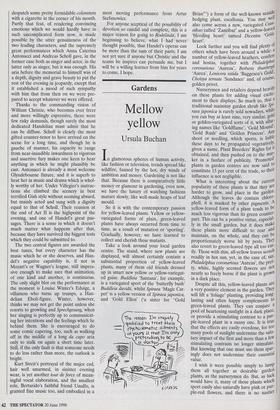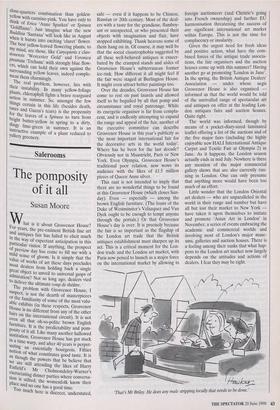Gardens
Mellow yellow
Ursula Buchan
In glamorous spheres of human activity, like fashion or television, trends spread like wildfire, fanned by the hot, dry winds of ambition and money. Gardening is not like that. Because there is comparatively little money or glamour in gardening, even now, we have the luxury of watching fashions mature slowly, like well-made heaps of leaf mould.
So it is with the contemporary passion for yellow-leaved plants. Yellow or yellow- variegated forms of plain, green-leaved plants have always occurred from time to time, as a result of mutation or 'sporting'. Gradually, however, we have learned to collect and cherish these mutants.
Take a look around your local garden centre. The stand, where new plants are displayed, will almost certainly contain a substantial proportion of yellow-leaved plants, many of them old friends dressed up in smart new yellow or yellow-variegat- ed guise. Buddleia 'Santana', for example, is a variegated sport of the 'butterfly bush' Buddleia davidii, whilst Spiraea 'Magic Car- pet' is a yellow version of Spiraea japonica, and 'Gold Ellen' Ca sister for "Gold Brian"') a form of the well-known seaside hedging plant, escallonia. You may well also come across a new, variegated Cean- othus called 'Zanzibar' and a yellow-leaved `bleeding heart' named Dicentra ,Gold- heart'. Look further and you will find plenty of others which have been around a while: a number of yellow-leaved heathers, conifers and hostas, together with Philadelphus.. coronarious 'Aureus', Berberis thunbergl! `Aurea', Lonicera nitida `Baggesen's Gold', Choisya ternata `Sundance' and, of course, golden privet. Nurserymen and retailers depend heavily on these plants for adding visual excite- ment to their displays. So much so, that a traditional mainstay garden shrub like Se- raea japonica is rarely sold nowadays, while, you can buy at least nine, very similar, O. or golden-variegated sorts of it, with allur- ing names like `Goldflame', 'Gold Mound, `Gold Rush' and 'Golden Princess'. Any shoot or seedling, which sports, is liable these days to be propagated vegetativelY: given a name, Plant Breeders' Rights for it obtained, and then pushed on to the mar', ket in a fanfare of publicity. 'Promoted plants in garden centres are now said to constitute 15 per cent of the trade, so their influence is not negligible. What is interesting about the current popularity of these plants is that they are harder to grow, and place in the garden. Although the leaves do contain chloro- phyll, it is masked by other pigments. A yellow-leaved form of a plant tends to be much less vigorous than its green counter- part. This can be a positive virtue, especial- ly in the small garden, but it does make these plants more difficult to rear and maintain, on the whole, and they can be proportionately worse hit by pests. TheY also revert to green-leaved type all too Os' ily. Those with thin, all-yellow leaves scorch readily in hot sun, yet, in the case of, say, Philadelphus coronarious ?wrens', the pret- ty, white, highly scented flowers are not nearly so freely borne if the plant is grown in a dark place.
Despite all this, yellow-leaved plants are a very positive element in the garden. They will lift a 'foliage' planting, providing long' lasting and often happy complements to green-leaved plants. They can conjure a pool of heartening sunlight in a dark place, or provide a stimulating contrast to a pur- ple-leaved plant in a sunny one. It is true that the effects are easily overdone, for too many pools of sunlight undermine the salu- tary impact of the first and more than a few stimulating contrasts no longer stimulate. But knowing that one must use them spar- ingly does not undermine their essential value.
I wish it were possible simply to lump them all together as desirable garden plants, as the nurserymen do. But, as luck would have it, many of those plants which sport easily also naturally have pink or pur- ple-red flowers, and there is no nastier close-quarters combination than golden- yellow with carmine-pink. You have only to think of Erica 'Anne Sparkes' or Spiraea `Goldflarne'. Just imagine what the new Budd/eia 'Santana' will look like in August when it bursts into exciting 'claret' flower. The best yellow-leaved flowering plants, to my mind, are those, like Caryopteris x clan- donensis 'Worcester Gold' and Veronica prostrata `Trehane' with strongly blue flow- ers, which can hold their own against the surrounding yellow leaves, indeed comple- ment them charmingly. The real problem, however, lies with their instability. In many yellow-foliage plants, chlorophyll fights a brave rearguard action in summer. So, amongst the few things certain in this life (besides death, taxes and Gazza's tears) is the propensity for the leaves of a Spiraea to turn from bright butter-yellow in spring to a dirty, dingy lime-green in summer. It is an instructive example of a plant reduced to gallery greenery.



























































 Previous page
Previous page